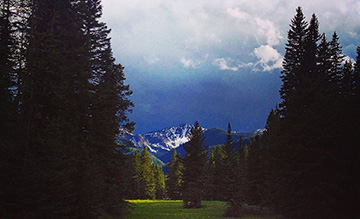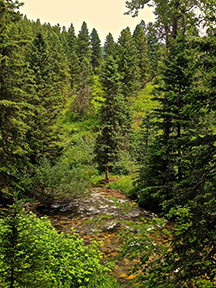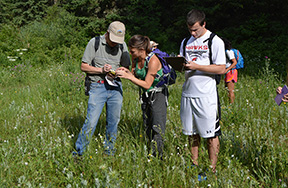The Tale of a Trail
A personal fight for public access.
Hyalite, Bozeman Creek, South Cottonwood: all places I take for granted because of their easy access. I can leave work at 5pm, hike to Blackmore Lake, and be back in town before sunset. But recently, while on a wilderness monitoring trip with the Greater Yellowstone Coalition (GYC) along South Cottonwood Creek, I spoke with Peter Bennett, the GYC's IT manager, and I’ve been forced to rethink trails, access, and the power of a letter to the editor.
Peter, how did you come to be in Cottonwood Canyon?
In 1973, as a freshman at MSU, I moved in with the outdoor writer Sam Curtis, who lived in the canyon. I did some hiking up Cottonwood at that time but access was very limited as there was a gate at the end of the road, and the trail was pretty vague because it wasn’t getting very much use. After moving away for a while, I came back to Bozeman in 1988, and called Sam. “Is there any place I can find a cabin?” I asked.
“Right up the road from me,” he said.
So I rented that cabin. That summer, Montana Wilderness Association led a hike to the top of Mt. Blackmore, coming up from Hyalite Reservoir, looking down into the head of Cottonwood Canyon and Fox Creek. They were telling us that the area was part of a section that was going to be logged by the timber company Plum Creek, and that there was a group trying to get together to purchase the land. In 1988-89, a group called Concerned Citizens of Cottonwood formed to protect the canyon. We were all volunteers.”

Were you involved with conservation before this?
Actually I was. After I graduated from college, I purchased some land up the main Boulder River south of Big Timber near Natural Bridge and I built my own cabin. This was back in '77 or '78. At that time there was some Wilderness, just a little section north of Yellowstone Park. But Lee Metcalf was interested in preserving a much bigger area—about one million acres of land that became the Absaroka-Beartooth Wilderness. And when I was living up there, I became aware of this effort to preserve this area. That winter, since I hadn’t finished my cabin, I was living back east with my parents near Washington, D.C. and there was an article that Lee Metcalf had passed away. So I wrote a letter to the editor of the Washington Post saying that we needed to pass the Wilderness Area in honor of Lee Metcalf and everything he’d done. And they published the letter. MWA got wind of it and said, “Wow, we’ve got a real-life person in Washington.” (Laughs) So they told me to come down to Capitol Hill.
You were working in conservation then?
No, this wasn’t a professional job. It was just something I did because I was really passionate about it. And when it came time for Concerned Citizens of Cottonwood to lobby, I said, “Well, I’ve done that.” We prepared brochures with photographs and maps and showed them to Congressional staff. It worked really well because we got people from all over the country to write letters to their Congressman and then in the fall of 1989, with the help of [former] Senator Max Baucus, we got approval for some funds from the Land and Water Conservation Fund to make the purchase. That put us on the map. All of the sudden Plum Creek took us seriously. At that point they raised the price to $4 million, which led to negotiating back and forth that lasted for several years. Finally, in 1992, the negotiations were complete and the purchase was done. It’s important to note that as this process moved along, people accused us of being NIMBYs (Not In My Back Yard), and demanded public access, so one of the things we were trying to do was create public access to the canyon so everybody could come use the area and this gave us more public support.

How did purchasing that land grow support for these collaborative processes in Bozeman?
It really got the ball rolling for the land exchanges. Look at a map from 1984, during the checkerboard system, where every other square is private. Look at the map now, and almost all of it is Forest Service. So the efforts of CCC really got the ball rolling for the exchanges in 1992 and 1998, when the rest of the Gallatin Range started becoming Forest Service ownership.
How much of a difference did it make that private citizens were sacrificing their free time and resources to protect this land?
A lot. It really made a big difference that it was private citizens rather than a national environmental organization. It impressed a lot of people that a small group was able to get the money and had the motivation.

Talking to Peter, I was amazed by the places he mentioned. He’d fought for Cottonwood, the Absaroka-Beartooth Wilderness, and land bordering Yellowstone. He was not alone, mind you, but his passion for these places led to action—action that benefits us all today.
Without these areas, Bozeman would be fundamentally different, and for most outdoor recreationists, much worse off. Of course, not every trail has a story like Peter’s. There isn’t always a drawn-out negotiation with powerful timber companies or transcontinental serendipity, but the trails didn’t just get there overnight. People have worked hard so that we might all enjoy them. Think about that and maybe write a letter to the editor next time private interests threaten to trump the public good.
For ways to get involved, contact the Gallatin Community Collaborative or the Greater Yellowstone Coalition.






